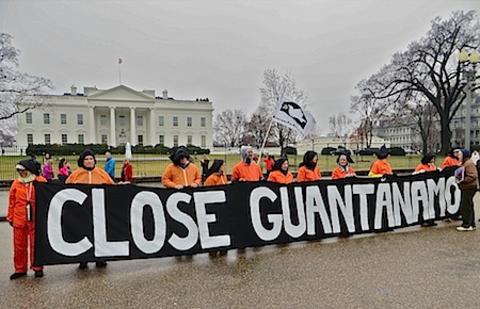What's Happening with Guantánamo?

Campaigners calling for the closure of Guantánamo outside the White House on January 11, 2014, the 12th anniversary of the opening of the prison (Photo: Andy Worthington via Flickr).
By Andy Worthington, September 9, 2014
The short answer to the question, "What's Happening with Guantánamo?" twelve years and eight months after the prison opened, is, unfortunately, "very little."
Seventeen men have been released since President Obama delivered a major speech on national security issues last May, in which he promised to resume releasing prisoners after a period of nearly three years in which releases had almost ground to a halt, because of obstacles raised by Congress and the president's unwillingness to spend political capital overcoming those obstacles.
Of the 17 men released, eleven were cleared for release in 2009 by a high-level, inter-agency Guantánamo Review Task Force that President Obama established shortly after taking office. However, of the 149 men still held, 75 others were also cleared for release by the task force, and their ongoing imprisonment is a disgrace. Four others have been cleared for release in recent months by Periodic Review Boards, established to review the cases of the majority of the men who were not cleared for release by the task force.
The majority of the cleared prisoners -- 58 in total -- are Yemenis, whose release was blocked by President Obama from January 2010 until his major speech last May. The trigger for this ban was a foiled airline bomb plot in December 2009, which had been hatched in Yemen, but although the president lifted his ban last May, none of the Yemenis cleared for release have yet been freed.
On Monday, the New York Times ran a major feature on Guantánamo, "Decaying Guantánamo Defies Closing Plans," looking at the current situation, which began with a claim that, last month, a Boeing C-17 military transport plane arrived at the prison to take six long-cleared prisoners, who cannot be safely repatriated, to Uruguay, after President Mujica offered to take them, as I reported here.
The Times claimed that, just before the plane arrived, Vice President Biden had called President Mujica, "pressing him to resettle the men," and also claimed that, although President Mujica had offered to accept the six men in January, by the time the U.S. was "ready for the transfer" this summer, President Mujica "was worried that it would be politically risky to follow through because of coming elections in his country," according to Obama administration officials who spoke to the Times, which added, "After four days of frantic negotiations between the two governments as the plane sat on the tarmac, the C-17 flew away without its intended passengers."
As AFP reported on Tuesday, however, Diego Canepa, an assistant secretary in President Mujica's office, denied the Times' claims. Canepa said, "At no point has any date been set," adding, "There is a commitment that [the six inmates] will be received here and the date is being finalized with the U.S. government." He also said that the question of the men's transfer would be settled "within two or three months."
Diego Canepa also refuted the claim about Joe Biden, telling journalists, "There was a conversation with Biden but there was in no way any pressure on Mujica."
According to the Times, the Obama administration "insists that the transfers to Uruguay will still occur after its election," and "as many as 14 other releases could also happen by the end of the year if they get approved," according to officials with knowledge of deliberations. Some, however, said a sense of urgency was required. Cliff Sloan, the State Department’s envoy for the closure of Guantánamo, appointed after Obama's speech last May, along with Paul Lewis, his counterpart in the Pentagon, said, "Every month counts. The period between now and the end of the year is critical because the path to closure demands substantial progress in moving people from Guantánamo."
After interviewing "two dozen administration, congressional and military officials," the Times noted that "[a] split is emerging between State Department officials, who appear eager to move toward Mr. Obama’s goal [of closing the prison before leaving office], and some Pentagon officials, who say they share that ambition but seem warier than their counterparts about releasing low-level detainees."
The problem is not just the release of the men cleared for release, but also the fate of the 70 others, who will need to be moved to the U.S. if the prison at Guantánamo Bay is to be closed. On that, however, Congress has imposed a ban for several years.
Releasing prisoners
According to the conditions on releasing prisoners that have been imposed by Congress for several years, lawmakers must be notified 30 days before the release of any prisoner, and the defense secretary must also sign off on the release, to guarantee that they cannot threaten the U.S. after being freed. The Times noted that Leon Panetta, the former defense secretary, "approved no low-level transfers," whereas his successor, Chuck Hagel, has approved the release of the 11 men released since President Obama's speech last May, although no one has been freed since the end of May this year.
According to the Times, news of the Uruguay deal "inspired similar talks with Brazil, Chile and Colombia," according to regional news reports, and in the meantime the Obama administration was also arranging deals "to repatriate four Afghans and a Mauritanian," deals that were completed in March, but that have not previously been reported. I profiled the four Afghans here, and reported the Mauritanian's story last year.
Despite this, there was no action from Chuck Hagel. The Times reported that he consults a number of national security agencies while examining proposed transfers, and some advisers, including Gen. Martin E. Dempsey, the chairman of the Joint Chiefs of Staff, "raised concerns about whether host countries can fulfill promises to keep watch on former detainees."
In May, the White House sent Chuck Hagel a memo "saying he should accept more than 'zero risk'" in approving prisoner transfers "because allowing the prison to remain open raised risks, too." However, referring to the certification that must be made prior to any prisoner release, Hagel told the Times at the time, "My name is going on that document. That’s a big responsibility."
In May, when the last prisoners were released -- five Taliban prisoners exchanged for Sgt. Bowe Bergdahl, the sole U.S. prisoner of war in Afghanistan -- the administration did not notify Congress, sparking disgraceful hysteria from Republican critics, who accused the administration of massive irresponsibility, and of breaking the law. As the Times stated, Hagel "said he was satisfied with the Qataris’ security assurances," and also "argued that delaying the transfer would put Sergeant Bergdahl’s life at risk."
One manifestation of the manufactured hysteria came from Republicans in the House of Representatives, who "retaliated by voting to forbid transferring any Guantánamo detainees anywhere" -- a completely unacceptable ban that, as the Times noted, "may not become law," although Rep. Howard McKeon (R-Ca.), the chair of the House Armed Services Committee, said, "I don’t see any support in the House for relaxing the current restrictions, or backing off our ban, in light of the president’s recent violation of the law."
However, Cliff Sloan "argued that it is possible the politics could change if most of the low-level prisoners can be transferred," because "[r]elocating a population of less than 100 to a domestic prison would be a smaller problem."
Legal challenges
Legally, the administration continues to rely on the Authorization for Use of Military Force, passed the week after the 9/11 attacks, to justify the ongoing detention of the prisoners. However, new habeas corpus challenges are expected after the end of major combat operations in Afghanistan in December. J. Alan Liotta, the senior Pentagon official dealing with detainee affairs, told the Times that "he expects the detention authority to remain viable because most detainees are considered part of Al-Qaeda or an associated force, rather than solely Taliban, and the broader armed conflict continues."
However, as the Times also noted, "law of war detention was designed for a conventional conflict that comes to an end after several years," and in a recent order, Justice Stephen G. Breyer "took the unusual step of noting that the Supreme Court has not been asked whether the law 'limits the duration' of indefinite detention in the more open-ended war against Al-Qaeda."
The Times also noted "signs of judicial impatience" in recent rulings -- an appeals court ruling allowing judges to "oversee the conditions of confinement at Guantánamo," and a decision taken in the District Court in Washington D.C. to allow a force-fed, hunger striking prisoner's lawyers to view videotapes of his force-feeding and "forcible cell extractions."
A decaying prison and an aging population
In other passages, the New York Times examined the decaying fabric of the prison, and problems with medical care and an aging population.
It was noted that parts of the prison "are fraying," and that the secretive Camp 7, where the "high-value detainees," including Khalid Sheikh Mohammed, are held, "is built on unstable ground -- a floor is described as buckling -- and will need replacement for any long-term use." Also of concern is the kitchen building, where "temperatures soar to 110 degrees at midday, steel supports are corroded, and workers must cover dry goods with plastic tarps during storms because of a leaky roof," and the state of the troops’ quarters, "where some guards are required to live six to a small shack, with poor ventilation and no attached bathrooms."
Last year, Southern Command requested around $200 million to update the prison, but the request was rejected by the Pentagon, although Congress "may approve about $23 million for two wish-list items: replacing the kitchen building and moving the medical clinic closer to Camps 5 and 6," where almost all the prisoners are now held.
One main problem, from a medical point of view, is the prison's aging population. The Times noted that the quality of the medical facilities has "raised concerns because Congress has prohibited sending even critically ill detainees to the United States" for treatment. Various Latin American countries were approached to take a prisoner in the case of an emergency, but they refused. Pentagon lawyers then "concluded that it was lawful not to evacuate a prisoner for urgent medical treatment," meaning that specialized doctors must be "prepared on short notice to fly in with equipment." As the Times added, however, "there are limits to what medical personnel can do without quick access to sophisticated hospital resources."
The Times also noted that the prison's senior medical officer "recently oversaw the creation of a 'Detainee Acute Care Unit' with several beds, ventilators, cardiac monitors, oxygen and other equipment." He said that "about 20 to 25 prisoners have conditions that he is monitoring, such as diabetes and high blood pressure," and "expects other problems, like heart disease, strokes and cancer to arise in coming years, as with any other population that is growing older." The prisoners' average age is currently 41.
One example of the medical problems caused by the remoteness of Guantánamo is the $1 million spent a few years ago on "a mobile cardiac catheterization lab" for a prisoner with serious heart problems who "ended up refusing the procedure." Officials said "the unused equipment, packed up but stored outdoors, has since decayed."
Just last month, a laser lithotripsy machine was brought to the prison "so that a visiting urologist could remove a detainee’s kidney stone." As the Times explained, this is "a simple outpatient procedure," which, nevertheless, "became very complicated because of the logistics" at Guantánamo.
As the 13th anniversary of the 9/11 attacks approaches, it is time that the obstacles preventing the release of prisoners and the eventual closure of Guantánamo are lifted, so that the abomination that is Guantánamo -- a legal, moral and ethical abomination that ought to shame all decent Americans -- is finally brought to an end.




